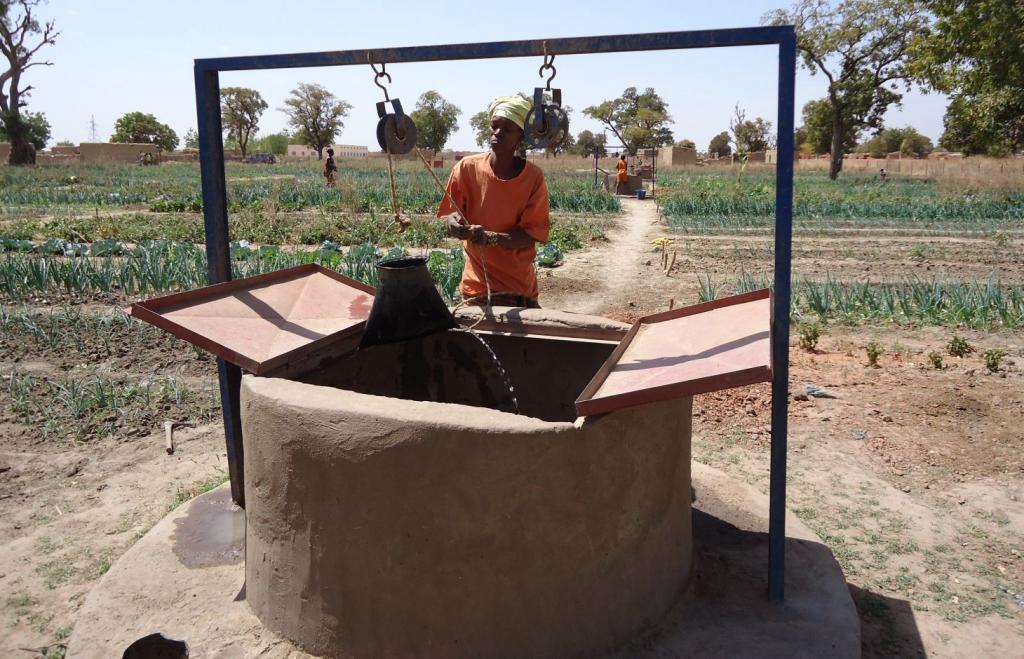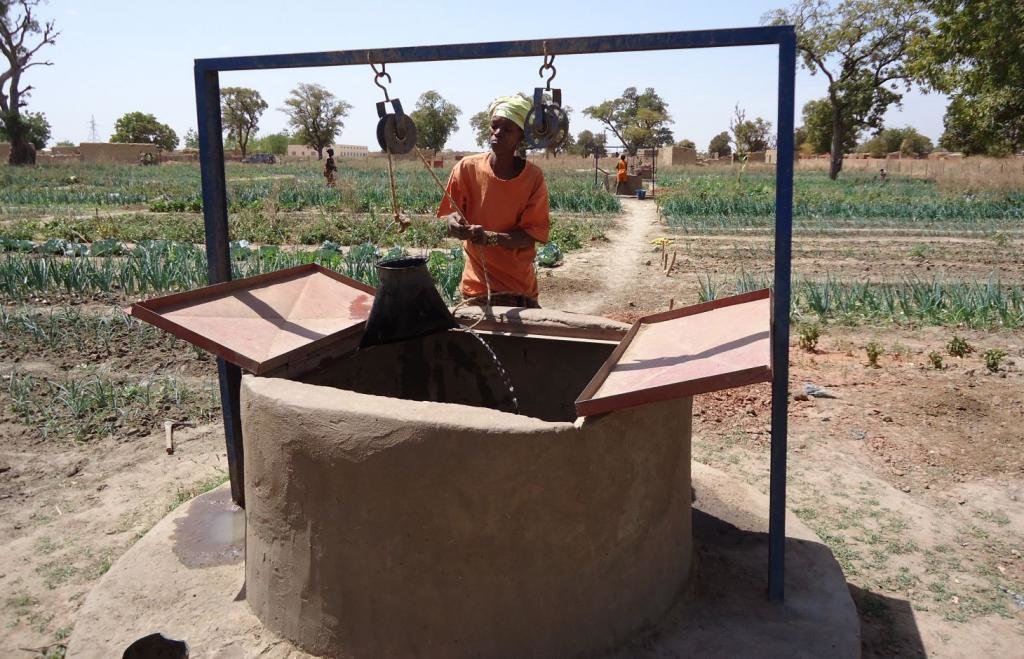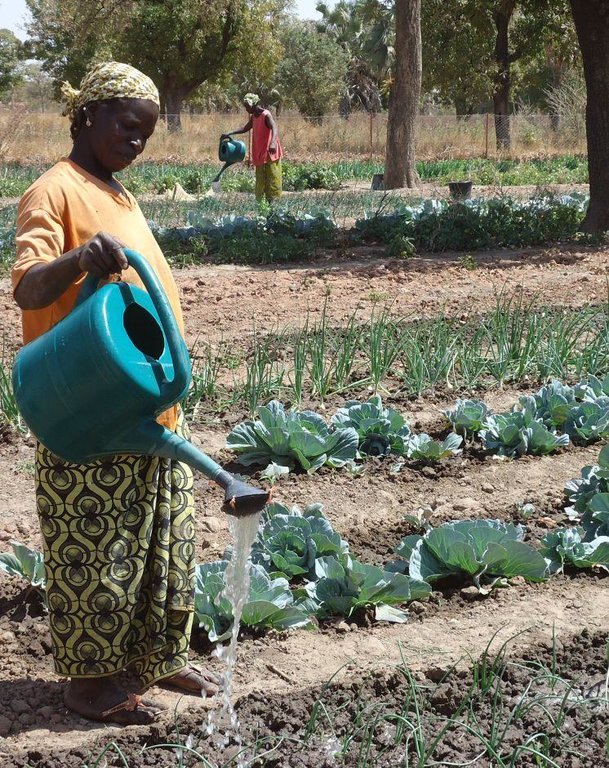Diversifying women’s income streams through market gardening [Мали]
- Создание:
- Обновить:
- Составитель: Dieter Nill
- Редактор: –
- Рецензент: Laura Ebneter
Diversification des revenus des femmes par des jardins maraichers
approaches_2501 - Мали
Просмотреть разделы
Развернуть все Свернуть все1. Общая информация
1.2 Контактные данные специалистов и организаций, участвующих в описании и оценке Подхода
Специалист по УЗП:
Diassana Joseph
jd@bornefondenmali.org
BØRNEfonden - Children & Youth Foundation
Мали
Специалист по УЗП:
Coulibaly Sourakata
sc@bornefondenmali.org
BØRNEfonden
Мали
Название организации (-ий), содействовавших документированию/оценке Подхода (если применимо)
Deutsche Gesellschaft für Internationale Zusammenarbeit (GIZ) - ГерманияНазвание организации (-ий), содействовавших документированию/оценке Подхода (если применимо)
BØRNEfonden - Children & Youth Foundation - Дания1.3 Условия, регламентирующие использование собранных ВОКАТ данных
Когда были собраны данные (на местах)?
01/07/2012
Составитель и ответственный/-ые специалист(-ы) согласны с условиями, регламентирующими использование собранных ВОКАТ данных:
Да
2. Описание Подхода УЗП
2.1 Краткое описание Подхода
Establishing vegetable plots for women enables them to increase their incomes and improve their health by increasing and diversifying agricultural production and improving the nutritional quality of their food.
2.2 Подробное описание Подхода
Подробное описание Подхода:
Market gardening also enables women to set up savings funds through their associations, builds their capacity to organise and manage market gardens and improves their cultivation techniques. Market gardens set up by women’s associations are usually sited adjacent to lowland areas or rivers so as to facilitate access to water, which is extracted from wells. The areas of these market gardens range from 0.5 to 1 hectare depending on the size of the association and the opportunities for selling produce locally. Allotment sizes range from 80 to 120 square metres per woman. The number of growers per market garden is no greater than 70 women per hectare and 35 women per half-hectare. Women receive a grant in the form of equipment and agricultural inputs. The wells created for the market gardens are 1.4 metres in diameter, have 60-centimetre-high well heads and 30-centimetre-wide footpaths from which to water crops. Eight wells are installed per hectare across the site.
1)A women’s association puts forward its needs, 2)The BØRNEfonden Development Unit carries out a scoping study, 3) Women are organised into an association, 4) The women contribute their share of the costs (10% of the investment costs), 5) A site with guaranteed access to water (i.e. close to the water table) is enclosed, 6)The market garden’s wells are dug, 7)Financial support is provided during the first growing season to pay for equipment and agricultural inputs, 8)The association undertakes a self-assessment and draws up a training plan, 9)BØRNEfonden’s Development Units provide time-limited advisory support, the duration of which depends on capacity-building needs and ranges from three to five years per village. A four-month period of advisory support is allotted to service providers (technical services and consultancies). In order to achieve the best outcomes, it is important to define rules and requirements upfront. These requirements are met by developing an internal control system and nominating an internal control committee. The beneficiaries draw up the management procedures for their site, setting out how it is accessed and how women farmers are selected through internal regulation. Selected committee members receive training in organising and managing the site. Management tools are put in place for this purpose. A plan for the growing season is drawn up with women growers, which means needs can also be evaluated. BØRNEfonden provides the funding. The production costs of sold crops are evaluated and the required funds are then reimbursed by growers through the payment of subscription fees, using a payment system that they have collectively defined. Subscriptions paid by the women are safely set aside in the savings fund created by the association in order to ensure repayments can be made on the equipment paid for by BØRNEfonden.
The women’s association makes a suitable site available and prepares the soil (clearing, grubbing and ploughing). It also contributes a 10% share of the investment and opens a bank account to provide for the repayment of the investment. BØRNEfonden undertakes site development works (laying out, well digging, fencing), carries out crop planning, buys in equipment and agricultural inputs, installs nurseries, establishes and allocates plots, prepares seedbeds, transplants seedlings, and deploys plant health products and fertilisers. BØRNEfonden supports scheme farmers with the growing, harvesting and sale of produce. Local authorities sign the service contracts established between BØRNEfonden and the private contractors hired when the market garden activities got underway (well digging and site fencing). Government and consultancy technical services are involved in performing studies, delivering training in cultivation techniques and monitoring vegetable growing plots.
2.3 Фотографии, иллюстрирующие Подход
2.5 Страна/ регион/ место, где применялся Подход
Страна:
Мали
Административная единица (Район/Область):
Mali
Более точная привязка места:
Yanfolila, Bougouni and Dioïla in the regions of Koulikoro and Sikasso
2.6 Даты начала и окончания реализации Подхода
Год начала реализации:
2008
2.8 Каковы цели/ задачи Подхода
The Approach focused mainly on SLM with other activities
To increase women's incomes and improve their health by increasing and diversifying agricultural production and improving the nutritional quality of their food. Market gardening also enables women to set up savings funds through their associations, builds their capacity to organise and manage market gardens and improves their cultivation techniques.
The SLM Approach addressed the following problems: lack of work, money and food for women; negative ecological impact due to traditional practices such as deforestation or gold mining;
2.9 Условия содействующие применению Технологии/ Технологий в рамках Подхода или затрудняющие его
Наличие/ доступность финансовых ресурсов и услуг
- затрудняют
lack of money
Treatment through the SLM Approach: BØRNEfonden provides the funding. The production costs of sold crops are evaluated and the required funds are then reimbursed by growers through the payment of subscription fees, using a payment system that they have collectively defined. Subscriptions paid by the women are safely set aside in the savings fund created by the association in order to ensure repayments can be made on the equipment paid for by BØRNEfonden.
Институциональные условия
- затрудняют
Treatment through the SLM Approach: BØRNEfonden supports scheme farmers with the growing, harvesting and sale of produce.
Осведомленность в области УЗП, доступность технической поддержки
- затрудняют
Treatment through the SLM Approach: BØRNEfonden undertakes site development works (laying out, well digging, fencing), carries out crop planning, buys in equipment and agricultural inputs, installs nurseries, establishes and allocates plots, prepares seedbeds, transplants seedlings, and deploys plant health products and fertilisers.
3. Участие и распределение ролей заинтересованных сторон
3.1 Заинтересованные стороны, участвующие в реализации Подхода и их роли
- местные землепользователи/ местные сообщества
- эксперты по УЗП/ сельскому хозяйству
- общественные организации
BØRNEfonden
- государственные власти (отвечающие за планирование или принятие решений)
Government and consultancy technical services are involved in performing studies, delivering training in cultivation techniques and monitoring vegetable growing plots.
3.2 Участие местных землепользователей/ местных сообществ на разных стадиях реализации Подхода
| Участие местных землепользователей/ местных сообществ | Перечислите участников и опишите их вовлеченность | |
|---|---|---|
| инициирование/ мотивация | пассивное | |
| планирование | интерактивное | |
| выполнение | интерактивное | |
| мониторинг/ оценка | пассивное | |
| Research | пассивное |
3.4 Принятие решений по выбору Технологии/ Технологий УЗП
Укажите, кто принимал решение по выбору применяемой Технологии/ Технологий:
- в основном землепользователи при поддержке специалистов по УЗП
Поясните:
Decisions on the method of implementing the SLM Technology were made by mainly by land users supported by SLM specialists
4. Техническая поддержка, повышение компетенций и управление знаниями
4.1 Повышение компетенций/ обучение
Проводилось ли обучение землепользователей/ других заинтересованных лиц?
Да
Укажите, кто проходил обучение:
- землепользователи
Тип обучения:
- в ходе работы
- обмен опытом между фермерами
- общие собрания
- курсы
4.2 Консультационные услуги
Есть ли у землепользователей возможность получать консультации?
Да
Укажите, где именно оказываются консультационные услуги:
- на полях землепользователей
Описание/ комментарий:
Advisory service is quite adequate to ensure the continuation of land conservation activities
4.3 Институциональная (организационная) поддержка
В ходе реализации Подхода были ли организованы новые институциональные структуры или поддержаны уже существующие?
- да, существенно
Укажите уровень, на котором структуры были укреплены или вновь созданы:
- местные
Укажите тип поддержки:
- финансовая
- повышение компетенций/ обучение
- оборудование
4.4 Мониторинг и оценка
Являются ли мониторинг и оценка частью Подхода?
Да
Комментарии:
Bio-physical aspects were ad hoc monitored by project staff through observations
Technical aspects were ad hoc monitored by project staff through observations
Socio-cultural aspects were ad hoc monitored by project staff through observations
Economic / production aspects were regular monitored by project staff through measurements
Area treated aspects were regular monitored by project staff through measurements
Land users involved aspects were regular monitored by project staff through measurements
Management of Approach aspects were ad hoc monitored by project staff through observations
There were no changes in the Approach as a result of monitoring and evaluation
There were no changes in the Technology as a result of monitoring and evaluation
4.5 Научные исследования
Были ли научные исследования частью Подхода?
Да
Укажите темы исследований:
- социология
- экономика / маркетинг
- экология
- технология
5. Финансирование и внешняя материальная поддержка
5.1 Годовой бюджет мероприятий по УЗП в рамках Подхода
Если точный годовой бюжет неизвестен, укажите примерный диапазон затрат:
- 2000-10000
Комментарий (например, основные источники финансирования/ ключевые доноры):
Approach costs were met by the following donors: international non-government (BØRNEfonden): 90.0%; local community / land user(s): 10.0%
5.2 Финансирование и внешняя материальная поддержка, предоставляемая землепользователям
Предоставлялась ли землепользователям финансовая/ материальная поддержка для применения Технологии /Технологий?
Да
5.3 Субсидии на отдельные затраты (включая оплату труда)
- оборудование
| Укажите, какие ресурсы были субсидированы | В какой степени | Опишите субсидии подробнее |
|---|---|---|
| техника | профинансированы полностью | |
| инвентарь/ инструменты | профинансированы полностью | |
- сельскохозяйственные
| Укажите, какие ресурсы были субсидированы | В какой степени | Опишите субсидии подробнее |
|---|---|---|
| семена | профинансированы полностью | |
| удобрения | профинансированы полностью | |
Если труд землепользователя был существенным вкладом, укажите, был ли этот вклад:
- добровольный
6. Анализ влияния и заключительные положения
6.1 Влияние Подхода
Сумел ли Подход помочь землепользователям внедрить и поддерживать технологии УЗП?
- Нет
- Да, немного
- Да, умеренно
- Да, существенно
This new occupation deters women from taking up traditional practices that involve deforestation or environmental damage (gold mining). In light of these very encouraging levels of income, women producers will be more interested in sustaining and continuing their market gardening activities.
Сумел ли Подход расширить возможности социально и экономически уязвимых групп?
- Нет
- Да, немного
- Да, умеренно
- Да, существенно
focus on women
Did other land users / projects adopt the Approach?
- Нет
- Да, немного
- Да, умеренно
- Да, существенно
The activity has been operating since 2008 with increasing success. Since 2008, 21 development units have supported the installation and management of 57 market gardens, 14 nutrition gardens (based on strip-farmed food crops and jujubes), and 286 wells across a total area of 32.3 hectares. The total number of women farmers involved stands at 2,752. Schemes were installed in 27 communes across the three circles of Yanfolila, Bougouni and Dioïla in the regions of Koulikoro and Sikasso. 26 villages benefited from the installation of market gardens in 12 rural communes in the Koulikoro Region. 31 villages benefited from the installation of market gardens in 15 communes in the Sikasso Region.
Did the Approach lead to improved livelihoods / human well-being?
- Нет
- Да, немного
- Да, умеренно
- Да, существенно
Dietary diversification resulting from the communities’ (and particularly children’s) access to vegetables and the introduction of certain crops like potato and French beans. The consumption of vegetables and having the financial means to buy different kinds of foods improve the nutritional quality of diets.
Did the Approach help to alleviate poverty?
- Нет
- Да, немного
- Да, умеренно
- Да, существенно
Some of these women have already been able to capitalise on their incomes by buying livestock (cows, small ruminants). Ensuring women are well organised across the market garden site, promoting good management and increasing the purchasing power of producers are equally important factors in achieving sustainability.
6.2 Основные причины, побуждающие землепользователей внедрять УЗП
- рост продуктивности
- рост прибыли (доходности) и рентабельности
- материальное стимулирование/ субсидии
6.3 Долгосрочная устойчивость мероприятий в рамках Подхода
Могут ли землепользователи самостоятельно (без внешней поддержки) продолжать применение того, что было реализовано в рамках Подхода?
- да
Если да, опишите как:
The women are now able to reproduce the same approaches. With BØRNEfonden’s support, they have the funds to buy good quality agricultural inputs, which guarantees good production. The savings held in their bank accounts help with equipment repayments.
6.4 Сильные стороны/ преимущества Подхода
| Сильные стороны/ преимущества/ возможности по мнению составителя или других ключевых специалистов |
|---|
| Environmental impacts: a sharp drop in the overcutting of trees to make charcoal, and a sharp drop in traditional gold mining activities and their negative environmental impacts |
| The consumption of vegetables and having the financial means to buy different kinds of foods improve the nutritional quality of diets. |
| Dietary diversification resulting from the communities’ (and particularly children’s) access to vegetables and the introduction of certain crops like potato and French beans. |
| Women’s takings from their vegetable crops range from 35,000 to 125,000 CFA francs, depending on the production scenario and location. We have recorded sales of between 7.5 and 8 tonnes of potato resulting from 25 crates of seed potato. Sold at a rate of 225 CFA francs per kilogram, this generates a total of between 1,687,500 to 1,800,000 CFA francs. |
|
Strengthening the capacities of women vegetable growers ensures the sustainability of this good practice. Indeed, the women are now able to reproduce the same approaches. With BØRNEfonden’s support, they have the funds to buy good quality agricultural inputs, which guarantees good production. The savings held in their bank accounts help with equipment repayments. |
| Market gardening is now being carried out at times when women would traditionally have been without work and lacking money and food. This new occupation deters women from taking up traditional practices that involve deforestation or environmental damage (gold mining). In light of these very encouraging levels of income, women producers will be more interested in sustaining and continuing their market gardening activities. Some of these women have already been able to capitalise on their incomes by buying livestock (cows, small ruminants). Ensuring women are well organised across the market garden site, promoting good management and increasing the purchasing power of producers are equally important factors in achieving sustainability. |
6.5 Слабые стороны/ недостатки Подхода и пути их преодоления
| Слабые стороны/ недостатки/ риски по мнению составителя или ответственных специалистов | Возможные пути их преодоления/снижения? |
|---|---|
| The constraints to report relate to: low-rainfall periods (drying up of wells), pests attacking crops, and problems selling crops (poor sales, low sale prices). |
7. Справочные материалы и ссылки
7.1 Методы сбора/источники информации
- выезды на места, полевые обследования
- опросы землепользователей
7.2 Ссылки на опубликованные материалы
Название, автор, год публикации, ISBN:
Manual of Good Practices in Small Scale Irrigation in the Sahel. Experiences from Mali. Published by GIZ in 2014.
Где опубликовано? Стоимость?
http://star-www.giz.de/starweb/giz/pub/servlet.starweb
Название, автор, год публикации, ISBN:
Procedures and technical specifications for market garden schemes, BØRNEfonden – Mali
Ссылки и модули
Развернуть все Свернуть всеСсылки
Нет ссылок
Модули
Нет модулей




